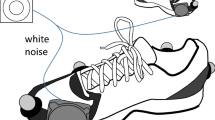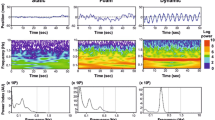Abstract
Purpose
The purpose of this study was to investigate the biomechanics according to vibro-perception threshold and vibration frequency during gait.
Methods
To this end, the vibro-perception threshold by the vibration frequency was measured and vibration was applied based on these findings during gait. To analyze the biomechanical property variations in the ankle joints during gait, a three-dimensional movement analysis system and biomechanical software was used. We analyzed the angles, moment and power of the ankle joints.
Results
The vibro-perception threshold measurement showed that the perception threshold differed depending on the area of stimulation and vibration frequency. The variations in biomechanical properties due to stimulation of the subperception threshold intensity (80%) was similar to those at the perception threshold. Also, the variations in biomechanical properties due to stimulation were dependent on the vibration frequency.
Conclusions
This indicates that vibratory stimulation could trigger variations in biomechanical properties in a manner dependent on the characteristics of the vibratory stimulation.
Similar content being viewed by others
References
Hubley-Kozey CL, Vezina MJ. Muscle activation during exercises to improve trunk stability in men with low back pain. Arch Phys Med Rehab. 2002; 83(8):1100–8.
Kim UC, Jang SJ, Park MY, Park SW. Prognostic factors of ambulation in stroke patients. J Kor Acad Rehab Med. 1992; 16(4):443–51.
Lee HS, Choi HS, Kwon OY. A literature review on balance control factors. Phys Ther Kor. 1996; 3(3):82–91.
Mazzeo RS, Cavanagh P, Evans WJ, Fiatarone M, Hagberg J, McAuley E, Startzell J. ACSM position stand on exercise and physical activity for older adults. Med Sci Sport Exer. 1998; 30(6):992–1008.
Lord SR, Ward JA, Williams P, Anstey KJ. Physiological factors associated with falls in older community-dwelling women. J Am Geriatr Soc. 1994; 42:1110–7.
Gravelle DC, Laughton CA, Dhruv NT, Katdare KD, Niemi JB, Lipsitz LA, Collins JJ. Noise-enhanced balance control in older adults. Neuroreport. 2002; 13(15):1853–6.
Dickstein R, Laufer Y, Katz M. TENS to the posterior aspect of the legs decreases postural sway during stance. Neurosci Lett. 2006; 393(1):51–5.
Lee SY, Yu M, Kim DW, Kim NG. Effects of postural stability using electrical stimulation on the lower limb. J Biomed Eng Res. 2009; 30(3):255–62.
Lee SY, Yu M, Kim NG, Kim DW. Evaluation of postural stability according to characteristics of electrical stimulation on the ankle muscles. J Biomed Eng Res. 2009; 30(6):521–8.
Mauter C, Mergner T, Bolha B, Hlavacka F. Human balance control during cutaneous stimulation of the plantar soles. Neurosci Lett. 2001; 302(1):45–8.
Eklund G, Hagbarth KE. Normal variability of tonic vibration reflexes in man. Exp Neurol. 1966; 16(1):80–92.
Burke D, Hagbarth KE, Löfstedt L, Walling BG. The response of human muscle spindle endings to vibration of noncontracting muscle. J Physiol. 1976; 261(3):673–93.
Burke D, Hagbarth KE, Löfstedt L, Walling BG. The response of human muscle spindle endings to vibration during isometric contraction. J Physiol. 1976; 261(3):695–711.
Bongiovanni LG, Hagbarth KE, Stjernberg L. Prolonged muscle vibration reducing motor output in maximal voluntary contractions in man. J Physiol. 1990; 423:15–26.
Bongiovanni LG, Hagbarth KE. Tonic vibration reflexes elicited during fatigue from maximal voluntary contractions in man. 1990; 423:1–14.
Eklund G, General features of vibration-induced effects on balance. Upsala J Med Sci. 1972; 77(2):112–24.
Yu M, Eun HI, Kim DW, Kwon TK, Kim NG. Effects of vibratory stimulus on postural balance control during standing on a stable and an unstable support. J Biomed Eng Res. 2007; 28(5):647–56.
Eun HI, Yu M, Kim DW, Kwon TK, Kim NG. The effects of human lower limb vibration on postural stability during unstable posture. J Biomed Eng Res. 2007; 28(5):628–35.
Lapole T, Pérot C. Effect of repeated Achilles tendon vibration on triceps surae force production. J Electromyogr Kines. 2010; 20(4):648–54.
Luo J, McNamara B, Moran K. The use of vibration training to enhance muscle strength and power. Sports Med. 2005; 35(1):23–41.
Curry EL, Clelland JA. Effects of the asymmetric tonic neck reflex and high-frequency muscle vibration on isometric wrist extension strength in normal adults. Phys Ther. 1981; 61(4):487–95.
Kihlberg S, Attebrant M, Gemne G, Kjellberg A. Acute effects of vibration from a chipping hammer and a grinder on the handarm system. Occup Environ Med. 1995; 52(11):731–7.
So HJ, Kim SH, Kim DW. A study on the changes in gait characteristics by applying sub-threshold vibration stimulus in the ankle. J Vibroeng. 2014; 16(7):3331–9.
So HJ, Kim SH, Kim DW. The effects of application site and time of vibration stimulation: changes in gait pattern and muscle activity. Appl Mech Mater. 2014; 479-80:475–9.
Samsung electro-mechanics Co. Ltd. Specification for approval. Suwon. Samsung electro-mechanics Co., Ltd; 2012. http://www.samsungsem.com/kr/. Accessed 16 Feb 2016.
Dagatron,corp. EC21 e-book for product catalogs. 2009. http://www.dagatron.com. Accessed 18 Feb 2016.
So HJ, Oh HY, Kim SH, Kim DW. The study on the correlation of vibration stimulation intensity and muscle activity. Appl Mech Mater. 2013; 284-7:1651–5.
Kandel ER, Schwartz JH, Jessell TM. Principles of neural science. 4th ed. McGraw-Hill; 2000.
Stanfield CL. Principles of human physiology. 4th ed. Pearson/Benjamin Cummings; 2011.
Fitz Gerald MJT, Gruener G, Mtui E. Clinical neuroanatomy and neuroscience. 5th ed. Saunders/Elsevier; 2007.
Han SK, Kim YS, Kwon SY, Lee KH, Choi NY. Sensory innervation in human hip joint capsule and pseudocapsule after total hip replacement-a morphological investigation. J Kor Orthopaedic Assoc. 2002; 37(2):240–4.
Yu M. Study on postural control using somatosensory stimulation. Dissertation. Jeonju: Jeonbuk National University; 2009.
Author information
Authors and Affiliations
Corresponding author
Rights and permissions
About this article
Cite this article
Kwak, K., Kim, HG. & Kim, DW. Variation of ankle biomechanical property according to vibro-perception threshold and vibration frequency. Biomed. Eng. Lett. 6, 16–25 (2016). https://doi.org/10.1007/s13534-016-0215-5
Received:
Revised:
Accepted:
Published:
Issue Date:
DOI: https://doi.org/10.1007/s13534-016-0215-5




